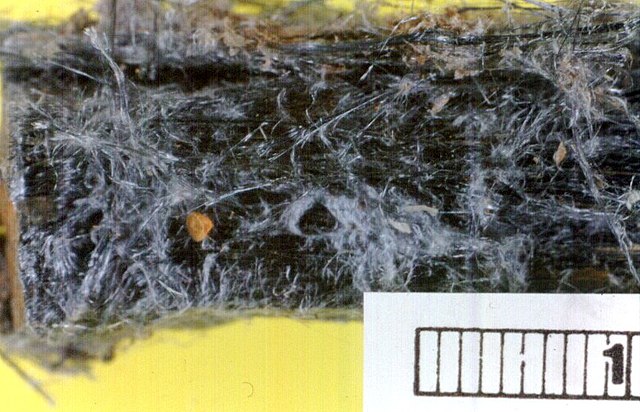
What is asbestos? Asbestos is a material made of lots of mineral fibers. It can be woven into shapes and it is fire-resistant.
Asbestos is a natural mineral that is mined and then processed. There are six different types of asbestos, and they are divided into two categories: amphibole and serpentine. The fibers in the amphibole asbestos are like needles. The amphibole asbestos are amosite, crocidolite, tremolite, anthophyllite, and actinolite. The other asbestos is chrysotile, and it is a serpentine asbestos, which means its fibers are curly. The structure of its fibers make chrysotile the most common asbestos.
Asbestos, despite being very dangerous, is an incredibly useful material. It is a thermal and electrical insulator, so it can be used in many materials to make them fireproof. Its insulating properties meant that it was a wonderful material to go into the walls of houses. It kept them heat in or out, depending on the season. It is also used in brake pads, because they heat up, as pipe insulation, and as a stabilizer in cement. Some asbestos was even used as filters in cigarettes.
There is synthetic asbestos, but the majority of asbestos is natural. The different types of asbestos form in different rocks, but they all have a similar way of forming. Let’s look at chrysotile, the most common asbestos. It forms in fissures and cracks in serpentine rocks. These rocks crack and shatter when they are under high temperature or pressure and water gets into the cracks, gradually widening them. The water dissolves some of the minerals from the rock and swirls them around inside the veins in the rock. At some point, some of the minerals get attached to an impurity and start to clump together. Once this starts, they begin to attach to each other, making longer and longer chains, spreading out through the cracks in the rock. It takes a long time for them to form and some of the fibers can be very long.
Asbestos has to be mined because it is all contained within rocks. It is fairly easy to find where the veins of asbestos are because they always come in specific types of rocks and the mining companies only have to find those rocks. Once the rocks are discovered, they are dug out of the walls of open pit mines. Once they have been removed, they have to be processed. The only way to get the asbestos out is to repeatedly smash the rocks and shake the bits off until all that is left is the asbestos fiber. Once the fiber is out, it can be spun in pretty much the same way as cotton.
Some of the major asbestos mining countries are Canada, Russia, China, Brazil, Kazakhstan, India, and South Africa. The amount of asbestos mined worldwide peaked in 1980 at 4.7 million tons and then started to drop. This was in line with countries discovering the dangers of asbestos and starting to ban it. The amount of asbestos mined in 2023 was about 1.3 million tons, so it has fallen considerably.
We think of asbestos as a modern problem, most probably connected with building in the 1960s and 1970s. However, asbestos has been around for thousands of years. The first known use of asbestos was about 4,500 years ago, when people in Finland use asbestos to make their cooking utensils stronger. Different civilizations used asbestos in different ways over the years. The Persians made material from it that could be cleaned by throwing it into the fire because asbestos is fireproof. The word asbestos comes from Ancient Greek but is actually a mistaken translation. “Asbestos” was the Greek word for quicklime, and was misused by Pliny the Younger to refer to asbestos, the material. The Greek word for asbestos was “amiantos”, which meant “unquenchable”. They used asbestos for the wicks in candles and the wicks never burned up.
Asbestos was used over the centuries, but production started to increase in the middle of the 19th century when mines in Canada were dug. The fireproof and heat resistant properties of the material were very useful in the age of steam power. The material was so useful that it ended up being everywhere, which turned out to be quite a problem when its dangers were discovered.
The problem with asbestos is that its fibers are very small, microscopic, and they are so light that they can float in the air for days. If you breathe them in, they will get to the lungs and cause a lot of scarring. They can lodge in the lung tissue and cause lung cancer or mesothelioma, which is a cancer of the lining of the lung. The fibers are so small that you won’t know you are breathing them in and won’t know they are in your lungs until you get sick. The dangers of asbestos were discovered in 1900, but the evidence wasn’t really there until the 1930s. Asbestos wasn’t banned until the 1980s because the asbestos industry did their best to cover up the data and mislead the public. It seems that companies with a dangerous product trying to mislead the public is not an uncommon thing. Asbestos is banned in 60 countries, but there are still 90,000 deaths from asbestos-related diseases every year. Asbestos has probably killed over a million people since it was used industrially. And this is what I learned today.
Image By John Hayman – Own work, Public Domain, https://commons.wikimedia.org/w/index.php?curid=2315683
Sources
https://pubs.usgs.gov/of/2002/of02-149/of02-149.pdf
https://www.atsdr.cdc.gov/noa/where_is_asbestos_found.html
https://indoorscience.com/blog/how-is-asbestos-formed
https://pubs.usgs.gov/publication/70031741
https://en.wikipedia.org/wiki/Asbestos
https://www.asbestos.com/asbestos
https://www.asbestos.com/asbestos/types
https://www.boyesturnerclaims.com/news/asbestos-mining-and-export-around-world
https://www.statista.com/statistics/264923/world-mine-production-of-asbestos
https://www.etymonline.com/word/asbestos
https://www.health.state.mn.us/communities/environment/asbestos/homeowner/heffects.html
